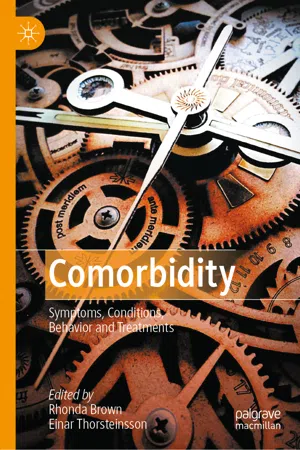1.1 What Is Comorbidity?
Comorbidity refers to any distinct clinical entity that coexists with or occurs during the clinical course of another illness or condition [1]. In other words, it refers to the co-occurrence of two or more distinct illnesses, disorders or conditions in a single individual. As a result of the comorbidity, some disorders tend to occur together more often than they occur alone. For example, anxiety, depressed mood and impaired sleep often co-occur, and in this instance, the co-occurrence appears to be the rule rather than the exception [2].
In this book, the term co-occurrence is used to refer to the coexistence of multiple symptoms (or clinical signs), whereas comorbidity specifically refers to the coexistence of multiple illnesses, disorders or conditions. For simplicity, the terms illness, disease, disorder and condition will be used interchangeably, as appropriate to the medical or psychological literatures referenced in each chapter.
It is not possible to provide a comprehensive analysis of all comorbid disorders and concurrent symptoms in this book. Nonetheless, the book represents a significant step forward in its coverage of a broad range of concurrent disorders including overweight/obesity, diabetes mellitus type-II, cardiovascular disease, sleep-disordered breathing, impaired sleep/insomnia, disordered eating (e.g. binge-eating disorder), anxiety, depression, fatigue, anorexia nervosa and bulimia nervosa.
In contrast, prior published books on the topic have tended to examine a limited number of comorbidities, including that between anxiety and depression [3–10], depression and other disorders [3], comorbidity with rheumatic disease [11], epilepsy [12], hypertension [9] and lifetime (or non-concurrent) comorbidity [4]. However, Sartorius and colleagues [13] have comprehensively detailed the clinical challenges of managing medical illnesses (e.g. cardiovascular disease, cancer, infectious disease) that tend to co-occur with mental and behavioural disorders, including substance abuse, eating disorders and anxiety; they covered the clinical management of the comorbidities.
In this book, a focus of attention is the comorbidity between overweight/obesity (or proxy measures of it, e.g. high body mass index [BMI] or weight gain) and impaired sleep/insomnia, which is increasingly observed in clinical practice, but as yet is not fully understood. Specifically, overweight/obese individuals tend to take longer to fall asleep (i.e. longer sleep onset latency) [14], sleep for a shorter time [15, 16], and have poorer sleep quality [17], relative to non-obese controls (or lower BMI). However, little else is known about this common comorbidity, although the sleep problems do typically resolve once the person loses weight [18]. In Chapter 3, this comorbidity will be discussed in greater detail as will the links between the phenomena and certain behaviour, which may play a causal role in contributing to the disorders. In Chapter 2, existing theories that seek to explain the presence and/or development of comorbid symptoms and disorders will be discussed.
Additionally, in Chapter 4, comorbidity between overweight/obesity and diabetes mellitus type-II, sleep-disordered breathing (e.g. obstructive sleep apnoea [OSA]) and affective distress (e.g. anxiety, depression) will be discussed. In Chapter 6, the concurrence between anxiety, depression, insomnia/impaired sleep, fatigue, gut pathology and gut symptoms will be discussed. In Chapter 5, comorbidity between eating disorders (e.g. anorexia nervosa, bulimia nervosa) and sleep problems, anxiety, depression, gut problems and hyperactivity will be examined. In Chapter 7, symptoms/conditions (e.g. chronic pain, fatigue) that frequently co-occur with impaired sleep, psychopathology, and other co-occurring conditions will be briefly discussed, as will the potential role played by unhelpful behaviour, including sleep-disrupting behaviour.
Statistically, disease comorbidity is typically evidenced by high co-prevalence estimates between the different diagnoses; symptom concurrence is evidenced by moderate to high correlations between two or more composite measures (e.g. total construct scores), using validated questionnaires [19]. Consistent with this approach, the book chapters will provide detailed research evidence illustrating the degree of concurrence between the aforementioned disorders and symptoms, as appropriate to the specific chapter. Further, where possible, the emphasis will be on presenting meta-analytic and prospective longitudinal study results, rather than cross-sectional correlational results. That is to say, our current conception of causality typically requires that the cause of an event must precede its’ onset in time. Only longitudinal (and experimental) study results can fulfil that criterion, to a greater or lesser degree.
However, appreciating the nature of the temporal relationship between two separate phenomena tells us little about the mechanism/s that underpin the relationship. As detailed in Chapter 2, there are few available theories to help guide the research on disease comorbidity, and as a result, we currently know little about the true nature of the phenomenon. Furthermore, a number of statistical and methodological (e.g. measurement) problems complicate our understanding of comorbidity, for example, by potentially inflating the extent of the observed relationship between the different phenomena. These methodological and statistical problems will be discussed in more detail in Chapter 8.
Finally, in Chapter 9, we will tie the threads together from the various chapters and reflect upon the most likely mechanism/s underpinning the development of comorbidity between the aforementioned disorders. In particular, we will discuss the likely role played by circadian rhythm dysfunction in the development of the disorders, along with the role played by sleep-disrupting behaviour and biological processes (e.g. elevated nocturnal body temperature). Finally, we will explore a broad range of novel, existing and repurposed therapy approaches that could show utility in treating the comorbid conditions.
